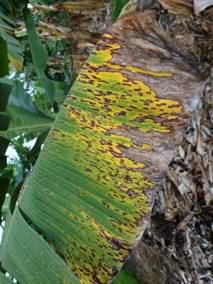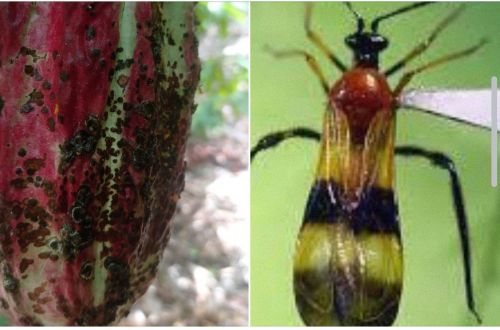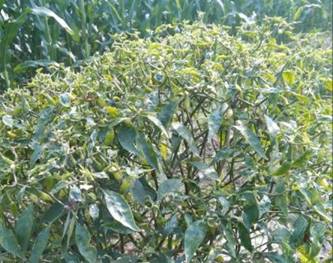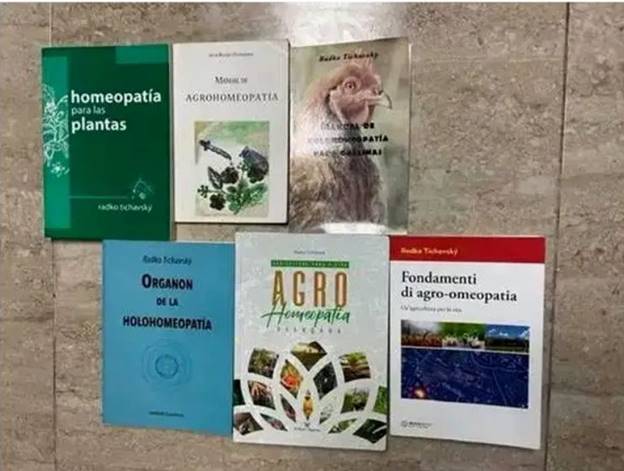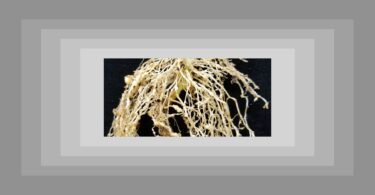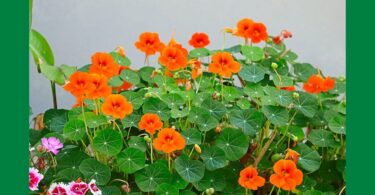Editor’s note: “JT potency” (Jenichen /Tichavsky) is a centesimal dilution followed by 500 succussions or five hundred continuous turns with a wooden stick to the right and 500 turns to the left (if handling larger volumes). The JT potency frequently has a better reaction in plants and it is very important in preparation of live bionosodes.
Dear Dr. Tichavsky,
We are facing a lot of problems with Banana Lace Wing bugs in banana and coconut fields. Along with this Yellow and Black Sigatoka disease is also damaging the banana leaves. I live in Andhra Pradesh, South India. In my area the wet season is hot and overcast and the dry season is sweltering, muggy, and mostly clear. Over the course of the year, the temperature typically varies from 65°F to 105°F and is rarely below 60°F or above 112°F.
Thank you so much.
Pavan Kumar Pokala
Dr. Radko Tichavsky:
Dear Pavan,
You can control Stephanitis typica with Silicea terra 6 CH alternated with Alumina at 6 CH potency. It is important to maintain good control over fertilization and not to exceed nitrogen in any of its forms (chemical or from animal excrements).
Excess of nitrogen forms large and soft tissues susceptible to the entry of sucking insects.
Preventively you can apply Calcarea carbonica 6 CH or Kalium carbonicum 6 CH once or twice a week for pest susceptible periods (depending on the severity of the infestation) to help restore the stability of the plant’s epidermis.
Azadirachta indica 6 CH helps to interrupt the insect’s reproductive cycle. As for homeopathic repellents, you can use essential oil of Eucalyptus spp. at 3 JT potency, dynamized in water mixed with Cymbopogon nardus 3 JT (also prepared from the essential oil).
As for black Sigatoka and yellow Sigatoka caused respectively by the fungi Mycosphaerella fijiensis and Mycosphaerella musicola, early control and monitoring of the disease is important, removing diseased tissues and burning out of the crop to slow its spread rate. Longer plant spacing helps to improve aeration and decrease the severity of these fungal diseases.
For the control of Mycosphaerella fijiensis, Trichoderma species are used, the most used are T. harzianum and T. viride.
As for holohomeopathic remedies, Arsenicum album 4 JT is used alternated with Melaleuca alternifolia 4 JT, this combination is effective against both fungi, the dynamization of Melaleuca alternifolia is made from essential oil of this plant.
Dear Dr. Tichavsky,
We have Cocoa bugs in Sona, Panama, on the coast with a temperature of 25°. they are feeding on the fruits and young branches.
Thank you
Maximo Caballero
Dr. RadkoTichavsky:
Dear Maximo,
For effective control of cocoa bugs (Monalonion dissimulatum) my first suggestion is to adjust the shading in cocoa plantations. This can influence the microclimate of the crop, affecting the presence and activity of the bugs.
Adequate shading increases the presence of natural predators of the pest such as spiders, predatory bugs (Reduviidae), and Chrysomelidae, which consume the nymphs and adults.
Beauveria bassiana, an entomopathogenic fungus is a good alternative that aligns with integrated pest management strategies of natural enemies, adheres to the surface of the insect, germinates and penetrates its exoskeleton, infecting it and eventually causing its death.
For holohomeopathic control of this pest on cocoa pods, use Clibadium surinamense 3 JT, made from a hydrolate of the plant, adding essential oil of Melaleuca alternifolia as an adjuvant.
Another very effective application against insect pests is a compound of catahua (latex of Hura crepitans), wild garlic (Gallecia integrifolia) and dried tobacco (Nicotiana tabacum) leaves of Nicotiana glauca, all prepared in hydroalcoholic TM and dynamized to 3 JT potency.
Dear Dr. Tichavsky,
Our Chili plants have small fruit with leaf curl (photo below). How do I solve it please? We are in Chennai India (mailing code 600005). It is a tropical wet and dry climate. Chennai in on the thermal equator and is also coastal, which prevents extreme variation in seasonal temperature. For most of the year, the weather is hot and humid.
Thank you
Krishna P.
Dr. Radko Tichavsky:
Dear Krishna,
The chili bell pepper in the photo appears to be suffering from viral infection, most likely a Tomato yellow leaf curl virus (TYLCV), which is transmitted to plants by vectors such as aphids, thrips and whiteflies among many other insects.
The first task is to interrupt the re-infection of the virus by the vectors by controlling the amount of nitrogen you apply to the plants.
Apply a preparation of Allium sativum essential oil at 3 JT potency alternated with Azadirachta indica 3 JT (dynamized from the essential oil). You should avoid over watering, you should avoid spray irrigation and only use drip irrigation. It is also important to maintain a good shading during the hottest hours of the day.
To combat chili curl virus, apply Salix babylonica 4 JT (from hydroalcoholic mother tincture), vitamin C at 4 JT potency, remedies that help the plant to deploy its defenses against the virus already established.
It is important to maintain good levels of elements such as zinc (Zn), manganese (Mn), sulfur (precursor of aminolevulinic acid) and copper (Cu), as they are essential for the proper functioning of the immune system of plants.
Aminolevulinic acid is produced in plants naturally only when they are slightly deficient in iron and magnesium, and this is important in the fight against the TYLCV virus.
That is, applying a complex of Zincum metallicum 6 CH, Cuprum metallicum 6 CH and Magnesium phosphoricum 30 CH decreases iron and magnesium levels, and at the same time increases the levels of zinc, copper, sulfur and manganese, preparing the plant to fight the virus.
Hello Dr. Tichavsky:
We have a freeze coming up in a week with temperatures in the 20’s at night. It will last for 3 days then most likely back in the 50’s (in Texas, U.S. ). We have some fruit trees that we planted last spring. Is there anything we can give to prepare the trees for the freeze or give during it, that will help protect them?
Thank you
Tiffany Miller Klubnik
Dr. Radko Tichavsky
Dear Tiffany,
Before talking about homeopathic remedies, it is important to prepare the trees against cold with proper mulching, good irrigation, and protective (living) fences around your crops to reduce air flow.
If your trees are in a particularly exposed location, the effects of wind chill can exacerbate cold damage. Another extremely important aspect of maintaining tree resistance to extreme conditions such as drought, heat, salinity, heavy metal toxicity and in this case rapid onset cold is inoculation with ectomycorrhizae, beneficial fungi that coexist with tree roots such as Glomus spp. or Rhizophagus irregularis,Scutellospora spp, Pisolithus arhizus, Funneliformis mosseae, or Septoglomus deserticola among many others.
You can purchase them on the internet and inoculate them into the roots of your fruit trees, or collect surface mulch around wild plants in your area that are cold hardy, prepare live bionosode at 2 JT potency (all dynamized in water) and water around your trees, the younger the trees the greater positive effect you can expect.
Salix babylonica 6 JT and Silicea terra 6 JT are also two very useful remedies to maintain the resistance of your trees to cold.
Dear Dr. Tichavsky,
Is there a remedy or other method to help encourage the composting process? I recently moved 9 month’s worth of compost to the side to cover with thick black plastic so that it would heat up. It was moist but not sodden. It never got hot or even really warm though… (and I am in southern Mexico so not even dealing with northern winter temps). It has been about 3 weeks since I moved it.
Thank you
Karen
Dr. Radko Tichavsky:
Dear Karen,
The behavior of the compost depends a lot on the material and the way it is deposited in the compost, i.e. in the compost must be established consecutive thin layers of green material (green leaves rich in nitrogen), dry material (rich in carbon) and a third layer of soil from your area that serves as inoculum of microorganisms that will activate the compost.
The cooling of your compost is due in this case to lack of nitrogen and absence of soil inoculum that activate the first stage of bacterial fermentation by aerobic microorganisms (Firmicutes group). Bacillus amyloliquefasciens, Bacillus subtillis, Bacillus megaterium and others.
To heat the compost, you should form successive layers of green, dry and soil in the compost heap up to a maximum height of 120 cm. Higher compost heights would encourage anaerobic organisms in the compost which are generally slower and less prolific in multiplying.
You can add live bionosode of Aloe vera and Agave gel and roots from your region to the compost at 3 JT potency. This will inoculate many species of the Bacillus family. You can also add a little cane sugar to nourish your bacteria in the beginning.
You should water your compost a little to keep it moist (as if it were a plant) but you should not overwater it (this will cool your compost again). It is not necessary to stir the compost or aerate it.
After a month and a half the temperature reaches its maximum and will start to drop naturally, this is when it enters the second phase of composting called fungal.
You can help in this phase by applying Trametes versicolor 3 JT or Ganoderma lucidum 3 JT dynamized from hydroalcoholic mother tincture of these wood-decomposing fungi.
Once the second phase is over, which takes about a month and a half to finish, and when the composted material is no longer distinguishable from leaves and logs, the basic compost recipe is ready to be used in your crop.
Online Diploma in Agricultural HoloHomeopathy (in English)
Transform your approach to farming with the Online Diploma in Agricultural HoloHomeopathy! This 6-month, fully online program is designed for farmers, agricultural professionals, and sustainability enthusiasts looking to implement effective, natural, and environmentally friendly farming practices. Duration: 6 months Mode: Online
Start Date: May 6th 2024
What You Will Learn:
- Foundations of Agricultural HoloHomeopathy: Discover how this practice improves soil health and crop productivity and resilience to climatic changes.
- Natural Pest Control: Learn to manage pests and diseases using homeopathic preparations, protecting biodiversity and avoiding harmful chemicals.
- Soil Fertility and Biodiversity: Enhance soil structure and promote a richly biodiverse environment with sustainable techniques.
- Concrete Results and Success Stories: Study real cases where Agricultural HoloHomeopathy has transformed farming practices, validating its effectiveness and benefits.
Diploma Benefits
- Certification: Obtain a certificate validating your knowledge and skills in Agricultural HoloHomeopathy.
- Taught by Dr. Radko Tichavsky, the diploma includes direct access to live sessions and exclusive materials.
- Practice Community: Join a network of professionals and enthusiasts with similar interests to exchange knowledge and experiences.
- Positive Environmental Impact: Contribute to sustainability and environmental health by applying what you’ve learned in your own projects or work environment.
Who Should Enroll?
This diploma is ideal for those committed to sustainable agriculture and looking to explore and apply innovative Agricultural HoloHomeopathy techniques to enhance the effectiveness, sustainability, and profitability of their farming practices.
Enrollment Open
Secure your spot in this unique program and take a step forward towards more sustainable and productive agriculture. Visit https://ecomenius.com/ for more information and to enroll.
Don’t miss the chance to be part of the revolution in sustainable agriculture with the Online Diploma in Agricultural HoloHomeopathy!
BOOKS ON HOLOHOMEOPATHY:
Many readers asked about Dr. Radko Tichavsky’s books. Below is a photo of them. They are available in Spanish, Italian and Portuguese. For ordering or information: [email protected]
New Video from Dr. Radko Tichavsky!
In this video, renowned Agrohomeopath Dr. Radko Tichavsky explains Holohomeopathy, the more advanced method of agrohomeopathy: https://youtu.be/GUUoO6Lt-U8 (English subtitles)



